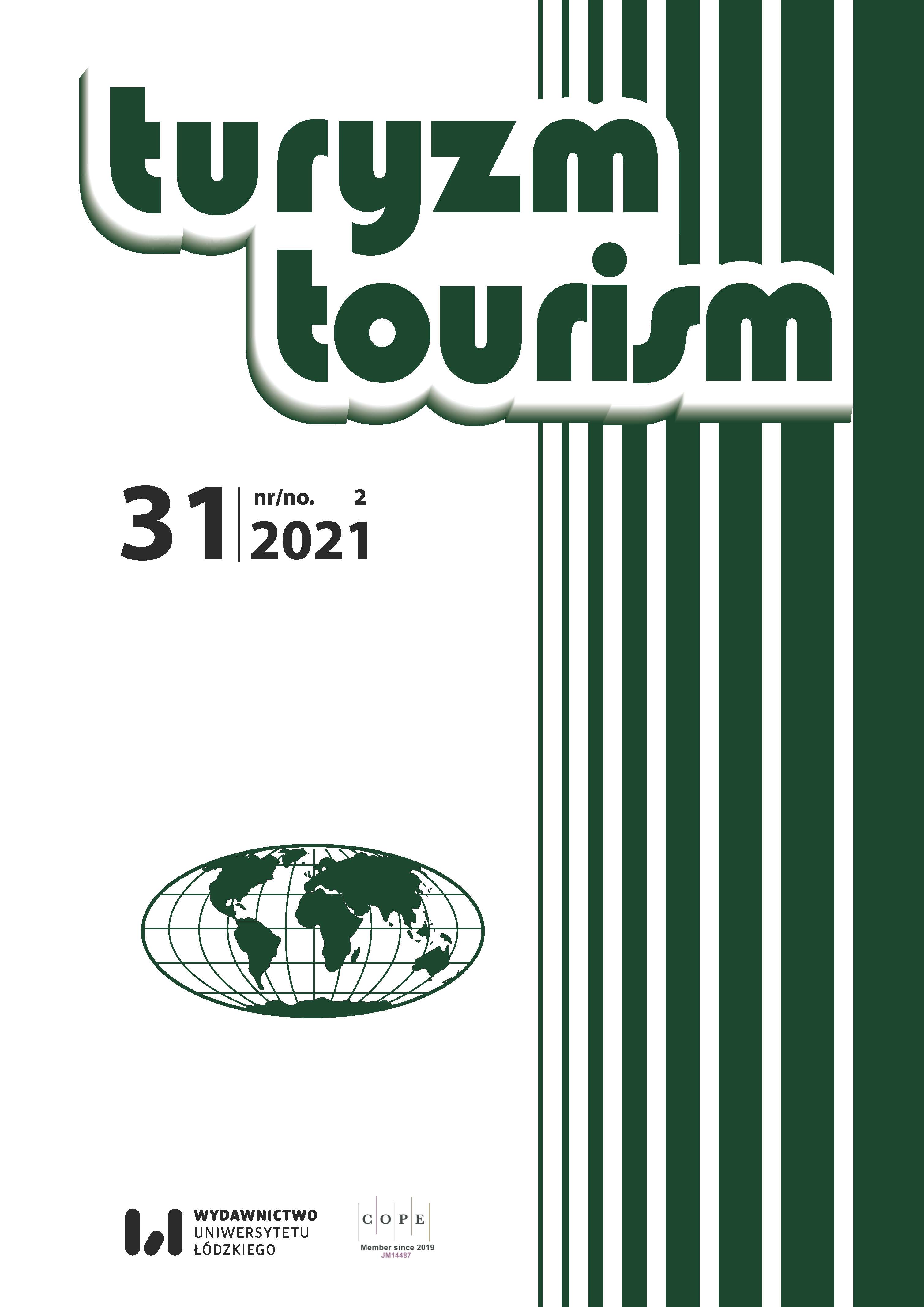A fine line between red and dark: Anti-communist film-induced tourism
DOI:
https://doi.org/10.18778/0867-5856.31.2.01Keywords:
anti-communism museums, dark tourism, film-induced tourism, red tourism, IndonesiaAbstract
This study explores the ‘30 September Movement’ that staged a communist coup in 1965 as travel motivation for an anti-communism museum. ‘Framing’ and ‘uses and gratifications’ theories were used for this case study. The findings concluded that negative film plots and scenes are signature themes that can be used as attributes of red or dark film motivations for tourism. The use of theories, such as ‘framing’ and ‘uses and gratifications’, along with reflexive thematic analysis has provided unique and valuable theoretical insights that may be overlooked by other analyses.
Downloads
References
30 September Movement (2020). Retrieved from: https://en.wikipedia.org/wiki/30_September_Movement (12.06.2019).
Google Scholar
Adams, K.M. (1998). Domestic tourism and nation-building in South Sulawesi. Indonesia and Malay World, 26 (75), 77–96. https://doi.org/10.1080/13639819808729913
Google Scholar
DOI: https://doi.org/10.1080/13639819808729913
Adams, K.M. (2016). Tourism and ethnicity in insular Southeast Asia: Eating, praying, loving and beyond. Asian Journal of Tourism Research, 1 (1), 1–28. https://doi.org/10.12982/AJTR.2016.0001
Google Scholar
DOI: https://doi.org/10.12982/AJTR.2016.0001
Azevedo, A. (2017). Lighthouse tourism: Is there a „dark” side? International Journal of Tourism Cities, 4 (1), 54–67. https://doi.org/10.1108/IJTC-03-2017-0019
Google Scholar
DOI: https://doi.org/10.1108/IJTC-03-2017-0019
Beeton, S. (2016). Film-induced tourism. Bristol–Buffalo–Toronto: Channel View Publications. https://doi.org/10.21832/9781845415853
Google Scholar
DOI: https://doi.org/10.21832/9781845415853
Bencivenga, A., Chiarullo, L., Colangelo, D. (2015). Film tourism in Basilicata. Almatourism – Journal of Tourism, Culture and Territorial Development, 6 (4), 241–260.
Google Scholar
Bolan, P., Boy, S., Bell, J. (2011). „We’ve seen it in the movies, let’s see if it’s true”. Authenticity and displacement in film-induced tourism. Worldwide Hospitality and Tourism Themes, 3 (2), 102–116. https://doi.org/10.1108/17554211111122970
Google Scholar
DOI: https://doi.org/10.1108/17554211111122970
Bowyer, E. (2017). The Influence of heritage sites as filming locations on tourists’ decisions to visit sites and their perceptions of them. Case study: „Game of Thrones”. Coactivity: Philosophy, Communication / Santalka: Filosofija, Komunikacija, 25 (1), 110–122. https://doi.org/10.3846/cpc.2017.286
Google Scholar
DOI: https://doi.org/10.3846/cpc.2017.286
Braun, V., Clarke, V. (2019). Reflecting on reflexive thematic analysis. Qualitative Research in Sport Exercise and Health, 11 (4), 589–597. https://doi.org/10.1080/2159676X.2019.1628806
Google Scholar
DOI: https://doi.org/10.1080/2159676X.2019.1628806
Brown, D., Lauricella, S., Douai, A., Zaidi, A. (2012). Consuming television crime drama: A uses and gratifications approach. American Communication Journal, 14 (1), 47–60.
Google Scholar
Cardoso, L., Estevão, C., Fernandes, C., Alves, H. (2017). Film induced tourism: A systematic literature review. Tourism & Management Studies, 13 (3), 23–30. https://doi.org/10.18089/tms.2017.13303
Google Scholar
DOI: https://doi.org/10.18089/tms.2017.13303
Çoban, F. (2018a). Political Reflections on dark tourism: The case of Turkey. In: M. Korstanje, B. George, Virtual traumascapes and exploring the roots of dark tourism (pp. 99–125). Hershey PA: IGI Global. https://doi.org/10.4018/978-1-5225-2750-3.ch006
Google Scholar
DOI: https://doi.org/10.4018/978-1-5225-2750-3.ch006
Çoban, F. (2018b). Dark tourism as a form of governmentality of fear. In: M. Korstanje, B. George, Virtual traumascapes and exploring the roots of dark tourism (pp. 126–149). Hershey PA: IGI Global. https://doi.org/10.4018/978-1-5225-2750-3.ch007
Google Scholar
DOI: https://doi.org/10.4018/978-1-5225-2750-3.ch007
Conway, J.C., Rubin, A.M. (1991). Psychological predictors of television viewing motivation. Communication Research, 18 (4), 443–463. https://doi.org/10.1177/009365091018004001
Google Scholar
DOI: https://doi.org/10.1177/009365091018004001
Costa, J.H. (2012a). Stuart Hall e o modelo „encoding and decoding”: Por uma compreensão plural da recepção. Revista Espaço Acadêmico, 12 (136), 111–121.
Google Scholar
Costa, J.H. (2012b). Os estudos culturais em debate: Um convite às obras de Richard Hoggart, Raymond Williams & E.P. Thompson. Acta Scientiarum. Human and Social Sciences, 34 (2), 159–168. https://doi.org/10.4025/actascihumansoc.v34i2.17706
Google Scholar
DOI: https://doi.org/10.4025/actascihumansoc.v34i2.17706
Costa, J.H. (2013). A atualidade da discussão sobre a indústria cultural em Theodor W. Adorno. Trans/Form/Ação, 36 (2), 135–154. https://doi.org/10.1590/S0101-31732013000200009
Google Scholar
DOI: https://doi.org/10.1590/S0101-31732013000200009
Costa, J.H., Korstanje, M.E. (2016). Nuevos conceptos, nuevas realidades: Revisando el rol de la belleza en la formación del turismo oscuro. Revista Turismo em Análise, 27 (3), 696–713. https://doi.org/10.11606/issn.1984-4867.v27i3p696-713
Google Scholar
DOI: https://doi.org/10.11606/issn.1984-4867.v27i3p696-713
Croy, W.G. (2004). The Lord of the Ring, New Zealand and tourism: Image building with film. Monash University, Faculty of Business & Economics.
Google Scholar
Curtin, S. (2010). The self‐presentation and self‐development of serious wildlife tourists. International Journal of Tourism Research, 12 (1), 17–33. https://doi.org/10.1002/jtr.734
Google Scholar
DOI: https://doi.org/10.1002/jtr.734
Dolezal, C., Trupp, A. (2015). Tourism and development in Southeast Asia. ASEAS – Austrian Journal of South-East Asian Studies, 8 (2), 117–124.
Google Scholar
Doyle, A. (2006). How not to think about crime in the media. Canadian Journal of Criminology and Criminal Justice, 48 (6), 867–885. https://doi.org/10.3138/cjccj.48.6.867
Google Scholar
DOI: https://doi.org/10.3138/cjccj.48.6.867
Festiani, S., Azizah, N., Rostiyani, Y. (2012). Lubang Buaya, the forgotten museum. Retrieved from: https://republika.co.id/berita/en/travelling-2/12/02/11/lz8646-lubang-buaya-the-forgotten-museum (12.06.2018).
Google Scholar
Fiske, J. (1983). The discourses of TV quiz shows or, school + luck = success + sex. Communication Studies, 34 (3), 139–150. https://doi.org/10.1080/10510978309368135
Google Scholar
DOI: https://doi.org/10.1080/10510978309368135
Foley, M., Lennon, J.J. (1996). JFK and dark tourism: A fascination with assassination. International Journal of Heritage Studies, 2 (4), 198–211. https://doi.org/10.1080/13527259608722175
Google Scholar
DOI: https://doi.org/10.1080/13527259608722175
Freire-Medeiros, B. (2009). The favela and its touristic transits. Geoforum, 40 (4), 580–588. https://doi.org/10.1016/j.geoforum.2008.10.007
Google Scholar
DOI: https://doi.org/10.1016/j.geoforum.2008.10.007
Gan, C., Wang, W. (2015). Uses and gratifications of social media: A comparison of microblog and WeChat. Journal of Systems and Information Technology, 17 (4), 351–363. https://doi.org/10.1108/JSIT-06-2015-0052
Google Scholar
DOI: https://doi.org/10.1108/JSIT-06-2015-0052
Goffman, E. (1974). Frame analysis: An essay on the organization of experience. Cambridge, MA, US: Harvard University Press.
Google Scholar
Handayani, B. (2017). Masih relevankah berkunjung ke Museum Lubang Buaya? Retrieved from: http://www.industry.co.id/read/7124/masih-relevankah-berkunjung-ke-museum-lubang--buaya#.WPY3foMtR18.facebook (30.06.2018).
Google Scholar
Handayani, B., Korstanje, M.E. (2017). Gazing at death: Dark tourism as an emergent horizon of research. New York: Nova Science Publishers.
Google Scholar
Hao, X., Ryan, C. (2013). Interpretation, film language and tourist destinations: A case study of Hibiscus Town, China. Annals of Tourism Research, 42, 334–358. https://doi.org/10.1016/j.annals.2013.02.016
Google Scholar
DOI: https://doi.org/10.1016/j.annals.2013.02.016
Ho, K.K., See-To, E.W. (2018). The impact of the uses and gratifications of tourist attraction fan page. Internet Research, 28 (3), 587–603. https://doi.org/10.1108/IntR-04-2017-0175
Google Scholar
DOI: https://doi.org/10.1108/IntR-04-2017-0175
Ikhwan, H., Yulianto, V.I., Parahita, G.D. (2019). The contestation of social memory in the new media: A case study of the 1965 killings in Indonesia. Austrian Journal of South-East Asian Studies, 12 (1), 3–16.
Google Scholar
Ivanova, M., Buda, D.M. (2020). Thinking rhizomatically about communist heritage tourism. Annals of Tourism Research, 84, 103000. https://doi.org/10.1016/j.annals.2020.103000
Google Scholar
DOI: https://doi.org/10.1016/j.annals.2020.103000
Jordan, P. (2014). Nation branding: A tool for nationalism. Journal of Baltic Studies, 45, 283–303. https://doi.org/10.1080/0162977 8.2013.860609
Google Scholar
DOI: https://doi.org/10.1080/01629778.2013.860609
Kami, M.I. (2017). Tentang Tugu Tani yang Didemo karena Dianggap Simbol Komunis. Detik News. Retrieved from: https://news.detik.com/berita/d-3663965/tentang--tugu-tani-yang-didemo-karena-dianggap-simbol-komunis (25.06.2018).
Google Scholar
Katz, E., Blumer, J.G., Gurevitch, M. (1974). The uses of mass communications: Current perspectives on gratifications research. In: W. Davison, F. Yu (eds), Mass communication research: Major issues and future directions (pp. 19–32). Beverly Hills: Sage Publishing.
Google Scholar
Kim, S., Reijnders, S. (2018). Asia on my mind: Understanding film tourism in Asia. In: S. Kim, S. Reijnders, Film Tourism in Asia (pp. 1–18). Singapur: Springer. https://doi.org/10.1007/978-981-10-5909-4_1
Google Scholar
DOI: https://doi.org/10.1007/978-981-10-5909-4_1
Krcmar, M. (2017). Uses and gratifications: Basic concepts. The International Encyclopedia of Media Effects, 1–13. https://doi.org/10.1002/9781118783764.wbieme0045
Google Scholar
DOI: https://doi.org/10.1002/9781118783764.wbieme0045
Krcmar, M., Greene, K. (1999). Predicting exposure to and use of violent television. Journal of Communication, 49 (3), 25–45. https://doi.org/10.1111/j.1460-2466.1999.tb02803.X
Google Scholar
DOI: https://doi.org/10.1111/j.1460-2466.1999.tb02803.x
kumparanNEWS (2017). Sejarawan LIPI: Tugu Tani Bukan Simbol Komunisme. Retrieved from: https://kumparan.com/@kumparannews/sejarawan-lipi-tugu-tani-bukan-simbol-komunisme (25.06.2018).
Google Scholar
Lennon, J. (2018). Kanchanaburi and the Thai-Burma railway: Disputed narratives in the interpretation of war. International Journal of Tourism Cities, 4 (1), 140–155. https://doi.org/10.1108/IJTC-06-2017-0033
Google Scholar
DOI: https://doi.org/10.1108/IJTC-06-2017-0033
Li, Y., Hu, Z.Y., Zhang, C.Z. (2010). Red tourism: Sustaining communist identity in a rapidly changing China. Journal of Tourism and Cultural Change, 8 (1–2), 101–119. https://doi.org/10.1080/14766825.2010.493939
Google Scholar
DOI: https://doi.org/10.1080/14766825.2010.493939
Loureiro, S.M.C., de Araujo, A.B. (2015). Negative film plot and tourists image and intentions: The case of „City of God”. Journal of Travel & Tourism Marketing, 32 (4), 352–365. https://doi.org/10.1080/10548408.2014.896769
Google Scholar
DOI: https://doi.org/10.1080/10548408.2014.896769
Macionis, N. (2004). Understanding the film-induced tourist. In: International tourism and media conference proceedings. Vol. 4 (pp. 86–97). Melbourn: Tourism Research Unit, Monash University.
Google Scholar
Macionis, N., Sparks, B. (2009). Film-induced tourism: An incidental experience. Tourism Review International, 13 (2), 93–101. https://doi.org/10.3727/154427209789604598
Google Scholar
DOI: https://doi.org/10.3727/154427209789604598
McAllum, K., Fox, S., Simpson, M., Unson, C. (2019). A comparative tale of two methods: How thematic and narrative analyses author the data story differently. Communication Research and Practice, 5 (4), 358–375. https://doi.org/10.1080/22041451.2019.1677068
Google Scholar
DOI: https://doi.org/10.1080/22041451.2019.1677068
Miles, W.F. (2002). Auschwitz: Museum interpretation and darker tourism. Annals of Tourism Research, 29 (4), 1175–1178. https://doi.org/10.1016/S0160-7383(02)00054-3
Google Scholar
DOI: https://doi.org/10.1016/S0160-7383(02)00054-3
O’Connor, N., Flanagan, S., Gilbert, D. (2008). The integration of film‐induced tourism and destination branding in Yorkshire, UK. International Journal of Tourism Research, 10 (5), 423–437. https://doi.org/10.1002/jtr.676
Google Scholar
DOI: https://doi.org/10.1002/jtr.676
Pan, S., Tsai, H., Lee, J. (2011). Framing New Zealand: Understanding tourism TV commercials. Tourism Management, 32 (3), 596–603. https://doi.org/10.1016/j.tourman.2010.05.009
Google Scholar
DOI: https://doi.org/10.1016/j.tourman.2010.05.009
Pan, Z., Kosicki, G.M. (1993). Framing analysis: An approach to news discourse. Political Communication, 10 (1), 55–75. https://doi.org/10.1080/10584609.1993.9962963
Google Scholar
DOI: https://doi.org/10.1080/10584609.1993.9962963
Reijnders, S. (2016). Stories that move: Fiction, imagination, tourism. European Journal of Cultural Studies, 19 (6), 672–689. https://doi.org/10.1177/1367549415597922
Google Scholar
DOI: https://doi.org/10.1177/1367549415597922
Ring, A., Yanamandram, V., Gretzel, U., Dolnicar, S. (2019). Conceptualizing vacation dedication. Current Issues in Tourism, 23 (14), 1732–1736. https://doi.org/10.1080/13683500.2019.1678572
Google Scholar
DOI: https://doi.org/10.1080/13683500.2019.1678572
Rubin, A.M. (1993). Audience, activity, and media use. Communication Monographs, 60 (1), 98–105. https://doi.org/10.1080/03637759309376300
Google Scholar
DOI: https://doi.org/10.1080/03637759309376300
Sabre, C. (2017). Between literary tourism and contents tourism: Marcel Proust and his Madeleine as a tourist attraction. International Journal of Contents Tourism, 2, 1–11.
Google Scholar
Seaton, P.A., Yamamura, T. (2018). Japanese popular culture and contents tourism. London: Routledge. https://doi.org/10.4324/9781315528694
Google Scholar
DOI: https://doi.org/10.4324/9781315528694
Slater, M.D. (2003). Alienation, aggression and sensation seeking as predictors of adolescent use of violent film, computer and website content. Journal of Communication, 53 (1), 105–121. https://doi.org/10.1111/j.1460-2466.2003.tb03008.X
Google Scholar
DOI: https://doi.org/10.1111/j.1460-2466.2003.tb03008.x
Spears, D.L., Josiam, B.M., Kinley, T., Pookulangara, S. (2013). Tourist see tourist do: The influence of Hollywood movies and television on tourism motivation and activity behavior. Hospitality Review, 30 (1), 4.
Google Scholar
Stafford, M.R., Stafford, T.F. (1996). Mechanical commercial avoidance: A uses and gratifications perspective. Journal of Current Issues & Research in Advertising, 18 (2), 27–38. https://doi.org/10.1080/10641734.1996.10505049
Google Scholar
DOI: https://doi.org/10.1080/10641734.1996.10505049
Strange, C., Kempa, M. (2003). Shades of dark tourism: Alcatraz and Robben Island. Annals of Tourism Research, 30 (2), 386–405. https://doi.org/10.1016/S0160-7383(02)00102-0
Google Scholar
DOI: https://doi.org/10.1016/S0160-7383(02)00102-0
Tüzünkan, D. (2017). The relationship between innovation and tourism: The case of smart tourism. International Journal of Applied Engineering Research, 12 (23), 13861–13867.
Google Scholar
Tzanelli, R. (2016). Thanatourism and cinematic representations of risk: Screening the end of tourism. Vol. 176. London: Routledge. https://doi.org/10.4324/9781315624105
Google Scholar
DOI: https://doi.org/10.4324/9781315624105
Viganò, G. (2003). Enogastronomy: A path towards the discovery of the local culture. Mediolan: Univerità Bocconi.
Google Scholar
Walters, T. (2016). Using thematic analysis in tourism research. Tourism Analysis, 21 (1), 107–116. https://doi.org/10.3727/1083 54216X14537459509017
Google Scholar
DOI: https://doi.org/10.3727/108354216X14537459509017
Yin, R.K. (2013). Case study research: Design and methods. Thousand Oaks, CA: Sage Publications.
Google Scholar
Downloads
Published
How to Cite
Issue
Section
License

This work is licensed under a Creative Commons Attribution-NonCommercial-NoDerivatives 4.0 International License.










